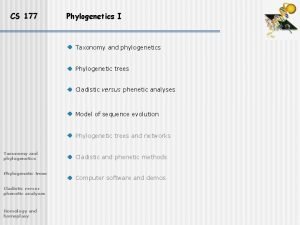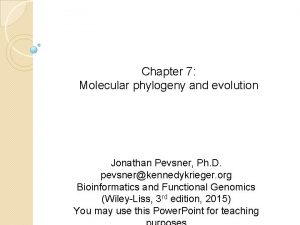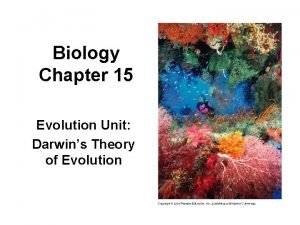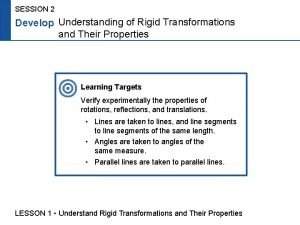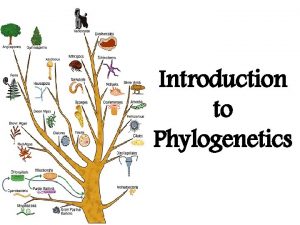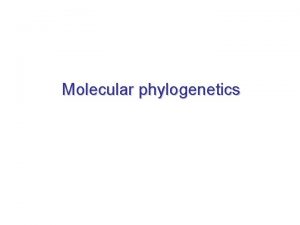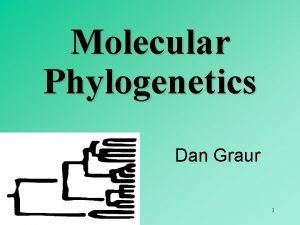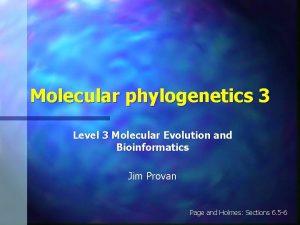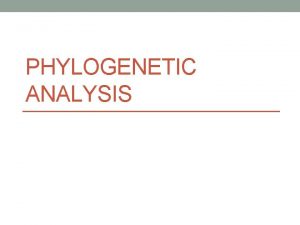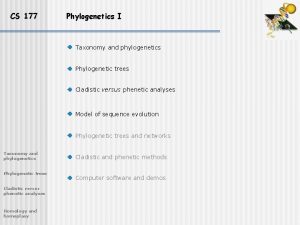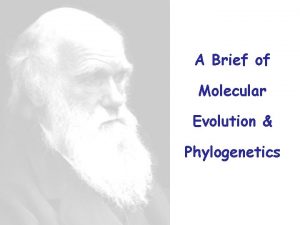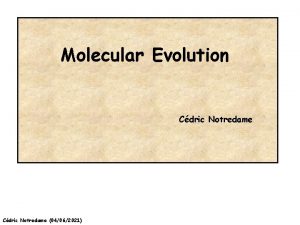Chapter 8 Molecular Phylogenetics Measuring Evolution Figure 8


















- Slides: 18

Chapter 8 Molecular Phylogenetics: Measuring Evolution

Figure 8. 1: The Tree of Life shows relationships among major groups of organisms Courtesy of Andrew J. Roger, Alastair B. Simpson, and Mitchell L. Sogin

Figure 8. 2: Sequence alignments can provide clues to evolutionary change by examining the effect of mutations occurring over time in species with a common ancestor

Figure 8. 3: An example of a phylogenetic tree showing the evolutionary relationships among four modern species

Figure 8. 4: Alignment of a portion of the casein gene from whales and related organisms, and a phylogenetic tree based on the differences among these genes

Figure 8. 5: DNA sequence changes in the cytochrome c gene reflect evolutionary distance

Figure 8. 6: Calculating the substitution rate (r) for two sequences that have changed over time

Figure 8. 7: Relative substitution rates for different regions of a chromosome, showing that functional constraints reduce the likelihood that mutations will be preserved

Figure 8. 8: Substitution mutations can be categorized as transitions or transversions

Figure 8. 9: Example of a single FASTA file with two sequences to compare

Figure 8. 10: Sample Clustal. W output for a protein alignment

Figure 8. 11: Phylogentic trees: (A) Rooted; (B) Unrooted

Figure 8. 12: A phylogenetic tree showing the relationships among six example species

Figure 8. 13: Three different linkage methods that could be used to compute the distance between two clusters

Figure 8. 14: A partial phylogenetic tree after merging clusters A and B and calculating branch lengths

Figure 8. 15: A partial phylogenetic tree after merging clusters (AB) with C and calculating branch lengths

Figure 8. 16: A partial phylogenetic tree after merging clusters (ABC) with D and calculating branch lengths

Figure 8. 17: A partial phylogenetic tree after merging clusters (ABCD) with E and calculating branch lengths
 8 levels of classification
8 levels of classification Phylogenetics
Phylogenetics Mega phylogenetics
Mega phylogenetics Physical state of covalent compounds
Physical state of covalent compounds Ionic covalent metallic
Ionic covalent metallic Zinc oxide + nitric acid → zinc nitrate + water
Zinc oxide + nitric acid → zinc nitrate + water Molecular biology evidence of evolution
Molecular biology evidence of evolution Molecular biology evidence of evolution
Molecular biology evidence of evolution Neutral theory of molecular evolution notes
Neutral theory of molecular evolution notes The fruit of evolution chapter 15
The fruit of evolution chapter 15 Neutral mutation
Neutral mutation Identify the type of congruence transformation
Identify the type of congruence transformation What is 6 figure grid reference
What is 6 figure grid reference Figure abcde is similar to figure vwxyz
Figure abcde is similar to figure vwxyz Washing machine solid or plane figure
Washing machine solid or plane figure Chapter 15:1 measuring and recording vital signs
Chapter 15:1 measuring and recording vital signs Chapter 2 tools and measuring instruments
Chapter 2 tools and measuring instruments Concept review measuring motion answer key
Concept review measuring motion answer key Chapter 29 measuring vital signs
Chapter 29 measuring vital signs

